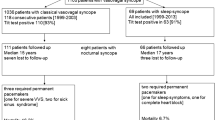Abstract
Current data suggest that up to 60 % of patients presenting to the emergency department with syncope leave the hospital without a defined etiology. Prior studies suggest a prevalence of psychiatric disease as high as 26 % in patients with syncope of unknown etiology. The objective of this study was to determine whether psychiatric disease is associated with an increased incidence of syncope of unknown etiology. Prospective, observational, cohort study of consecutive ED patients >18 presenting with syncope was conducted from 6/03 to 7/06. Patients were queried in the ED and charts reviewed for a history of psychiatric disease and use of psychiatric medication. Data were analyzed using SAS v9.2 with Fisher’s exact tests. We enrolled 518 patients who presented to the ED after syncope, 161 (31 %) did not have an identifiable etiology for their syncopal event; 166 patients (32 %) had a history of or current psychiatric disease. Among men with psychiatric disease, 37 % had an unknown etiology of their syncopal event, compared to 23 % of men without psychiatric disease (p = 0.04). However, among women with syncope of unknown etiology, there was no significant difference between those with and without psychiatric disease (34.4 vs. 32.7 %) with p = 0.77. Our results suggest that men with psychiatric disease have an increased incidence of syncope of unknown etiology. Given this relationship, clinicians might consider screening for psychiatric disorders in syncopal patients when no clear etiology can be identified.
Similar content being viewed by others
References
Lamb LE, Green HC, Combs JJ, Cheeseman SA, Hammond J (1960) Incidence of loss of consciousness in 1980 air force personnel. Aeromed Acta 31:973–988
Murdoch BD (1980) Loss of consciousness in healthy South African men: incidence, causes and relationship to EEG abnormality. S Afr Med J 57:771–774
Ganzeboom KS, Colman N, Reitsma JB, Shen WK, Wieling W (2003) Prevalence and triggers of syncope in medical students. Am J Cardiol 91:1006–1008
Williams RL, Allen PD (1962) Loss of consciousness. Incidence, causes and electroencephalographic findings. Aeromed Acta 33:545–551
Savage DD, Corwin L, McGee DL, Kannel WB, Wolf PA (1985) Epidemiologic features of isolated syncope: the Framingham study. Stroke 16:626–629
Ganzeboom KS, Mairuhu G, Reitsma JB, Linzer M, Wieling W, van Dijk N (2006) Lifetime cumulative incidence of syncope in the general population: a study of 549 Dutch subjects aged 35–60 years. J Cardiovasc Electrophysiol 17:1172–1176
Sarasin FP, Louis-Simonet M et al (2001) Prospective evaluation of patients with syncope: a population-based study. Am J Med 111:177–184
Farwell DJ, Sulke AN (2004) Does the use of a syncope diagnostic protocol improve the investigation and management of syncope? Heart 90:52–58
Linzer M, Varia I, Pontinen M, Divine GW, Grubb BP, Estes NA (1992) Medically unexplained syncope: relation to psychiatric illness. Am J Med 92:18S–25S
American Psychiatric Association (2000) Diagnostic and statistical manual of mental disorders, 4th edn. American Psychiatric Association, Washington, DC
Ventura R, Maas R, Rüppel R, Stuhr U, Schuchert A, Meinertz T, Nienaber CA (2001) Psychiatric conditions in patients with recurrent unexplained syncope. Europace 3:311–316
Kapoor WN (1995) Work up and management of patients with syncope. Med Clin North Am 79:1153–1170
Olshansky B, Grubb B (Eds) (2005) Syncope: mechanisms and management, 2nd edn. Wiley-Blackwell, Malden, pp 214–217
Kapoor WN, Fortunato M, Hanusa BH et al (1995) Psychiatric illnesses in patients with syncope. Am J Med 99:505–512
Kapoor WN (1983) A prospective evaluation and follow-up of patients with syncope. N Engl J Med 309:197–204
Lipsitz LA (1983) Syncope in the elderly. Ann Intern Med 99:92–105
Linzer MF, Felder A, Hackel A et al (1990) Psychiatric syncope: a new look at an old disease. Psychomatics 31:181–188
McGrady A, Kern-Buell C, Bush E, Khuder S, Grubb BP (2001) Psychological and physiological factors associated with tilt table testing for neutrally mediated syncopal syndromes. Pacing Clin Electrophysiol 24:296–301
Barrett-Connor E, Palinkas LA (1994) Low blood pressure and depression in older men: a population based study. BMJ 308:446–449
Grossman SA, Shapiro NI, Lee LL et al (2005) Women and syncope: impact of gender on the frequency and etiology of elderly patients presenting to the Emergency Department with Syncope. J Gerontol A Biol Sci Med Sci 60:1202–1205
Anson O, Carmel S, Levin M (1991) Gender differences in the utilization of emergency room services. Women Health 17:89–103
Conflict of interest
None.
Author information
Authors and Affiliations
Corresponding author
Rights and permissions
About this article
Cite this article
Wiener, Z., Shapiro, N.I., Chiu, D.TW. et al. The prevalence of psychiatric disease in emergency department patients with unexplained syncope. Intern Emerg Med 8, 427–430 (2013). https://doi.org/10.1007/s11739-013-0946-6
Received:
Accepted:
Published:
Issue Date:
DOI: https://doi.org/10.1007/s11739-013-0946-6




